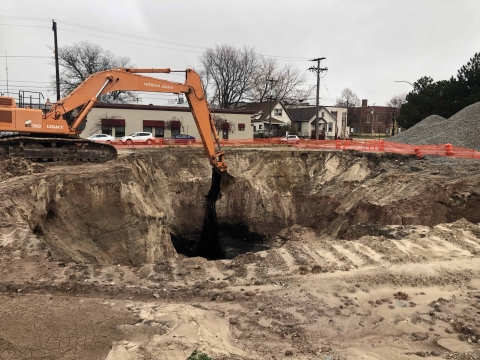Effective and efficient soil remediation techniques for site cleanup
When you need to develop an effective soil remediation strategy for contaminated sites, the Environmental Protection Agency recommends short-term exposure prevention and long-term cleanup goals as essential strategic elements.
Exposure to soil contamination may occur via direct pathways such as ingestion, inhalation or skin contact with soil particles. Or it can happen through indirect pathways such as consuming food crops grown in contaminated soil. Short-term exposure prevention may include limiting site access, changing site use or installing barriers to prevent human contact with contaminated soil. However, long-term solutions may focus on cleanup activities (in situ or ex situ) to reduce or eliminate soil contamination. This blog post discusses some of the key in situ soil remediation techniques used during cleanup.
An overview of key in situ soil remediation techniques
In situ (in place) soil remediation technologies involve implementing physical, chemical and biological processes to the subsurface to degrade or immobilize contaminants without removing soil. A major advantage of in situ soil remediation techniques is the ability to address contamination, which may not be readily excavated because of depth, nearby structures or other site limitations. In situ remediation methods also reduce the amount of waste, including hazardous, to be managed at treatment facilities or landfills. Some commonly used in situ soil remediation techniques include:
In Situ Chemical Reduction.
Placing a reductant or a reductant-generating material in the soil subsurface helps degrade toxic organic compounds and non-metallic oxyanions (nitrate) and to immobilize metals like chromium. The most commonly used reductants are zero-valent iron, sodium dithionite, hydrogen sulfide, ferrous iron and sulfide salts. In situ chemical reduction is particularly helpful for chlorinated organic compounds which may be resistant to natural degradation. The efficacy of this technique depends on the contamination type and accurate delivery of reductants to target zones in the soil. Depending on the specific contaminants and reductant selected, there may be potential for methane production, accumulation of "daughter product" contaminants and/or contaminant rebound.
In Situ Chemical Oxidation (ISCO).
Oxidants such as hydrogen peroxide, permanganate, ozone and persulfate may also be used to degrade harmful contaminants in soil. ISCO is frequently used to treat petroleum hydrocarbons. Similar to in situ chemical reduction, in situ chemical oxidation faces the challenge of delivering chemical amendments to target zones and the potential for contaminant rebound.
It is noteworthy that for in situ chemical reduction, in situ chemical oxidation, and other in situ techniques, specific challenges may emerge depending on the implementation mode— injection or blending. Successful delivery of injected amendments may be influenced by factors like soil type, depth of impact (unsaturated vs. saturated) and groundwater flow, among others. Successful amendment via blending may depend on depth, the staging area for larger excavation/mixing equipment, post-remediation redevelopment considerations, geotechnical properties after mixing, etc.
Enhanced bioremediation.
Enhanced in situ bioremediation introduces physical, chemical and biological changes to encourage native microbial growth in the soil so biochemical processes can break down contaminants into harmless byproducts. Enhanced bioremediation is particularly instrumental in breaking down chlorinated organic compounds.
In aerobic bioremediation, nutrients are injected into the soil to accelerate aerobic co-metabolism. In anaerobic in situ bioremediation, nutrient injection leads to accelerated reductive dechlorination to break down chlorinated organic compounds. The best bioremediation approach depends on the types of contaminants and the on-site conditions.
While implementing enhanced bioremediation, it is important to consider any geochemical conditions unfavorable to microbes. This technique also requires long-term monitoring to ensure the breakdown of contaminants into byproducts.
In situ stabilization.
In situ solidification and stabilization are closely related technologies used to treat radioactive, hazardous and mixed contaminants in the soil. Solidification techniques encapsulate waste into granular particulates or monolithic blocks, clay-like material or other solid physical forms. Stabilization methods reduce contaminants such as chromium (VI) into chromium (III) — a less soluble and less toxic form. Chemical stabilization uses agents such as soluble silicates, phosphates, carbon, organo-clays and sulfur-based binders to reduce contaminant mobility through physical or chemical reactions with the contaminant instead of the soil or sediment. As a result, the dosage of agents is critical to ensure complete soil remediation.
Phytoremediation.
Plants are also used to degrade, contain, immobilize or extract contaminants such as metals, volatile organic compounds, petroleum hydrocarbons and others from the soil. This in situ soil remediation technique is best suited for sites with large areas of shallow contamination. High contaminant levels can make this technique ineffective as toxicity might inhibit plant growth. Phytoremediation is most often used in conjunction with other soil treatment methods or implemented as a final polishing step for site remediation. Although the method depends on a number of factors, including the depth of contamination, the root system's depth, seasonality and long-term monitoring, it is significantly less expensive than excavating large volumes of soil for ex situ treatment.
Determining the best soil remediation technique for your project
Each of these in situ soil remediation techniques has specific advantages and drawbacks. To determine the effectiveness and suitability of these techniques for your project, you need an environmental expert who can plan a remediation strategy that fits your budget, timeframe and future site use. At Fehr Graham, our team of experienced environmental engineers and scientists has helped municipalities and developers with soil remediation techniques since the 1970s. Our in-house expertise has been instrumental in successfully completing land redevelopment and soil remediation projects, including cleaning up an oil spill, revitalizing a former gas station site and removing underground storage tanks. From developing initial soil sampling and analysis plans to creating cost-effective remediation strategies and preparing remediation completion reports for regulatory agencies, we have helped communities across the U.S. mitigate soil contamination risks.
To learn more about how Fehr Graham can help you understand and adhere to the updated Illinois PFAS standards for groundwater and drinking water, contact us or give us a call at 920.453.0700
 |
Annie Ray is a Project Hydrogeologist who works with technical teams to investigate and remediate contaminated sites and provide environmental due diligence and regulatory coordination. She reports on fieldwork programs, providing project management support and proposal development. Contact her at |
Collaborative, Insightful, Results-Driven Solutions
Fehr Graham provides innovative engineering and environmental solutions to help improve the lives and communities of our customers.

